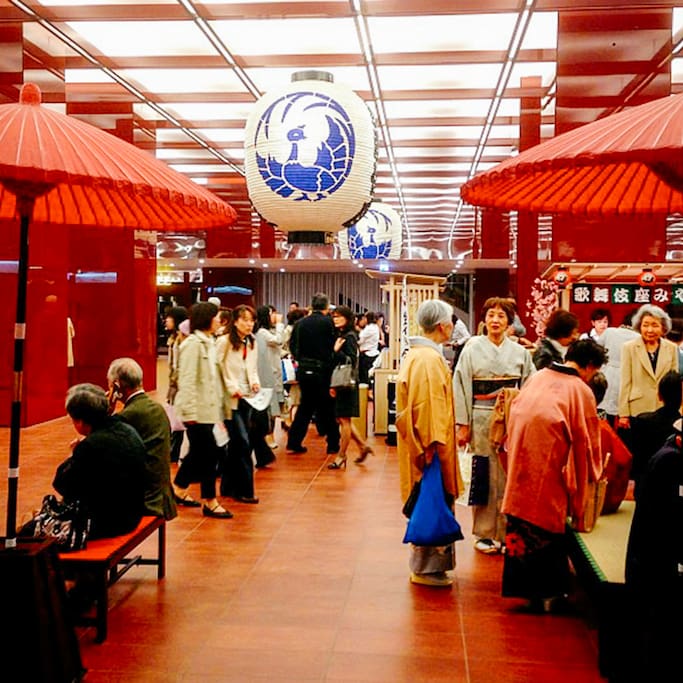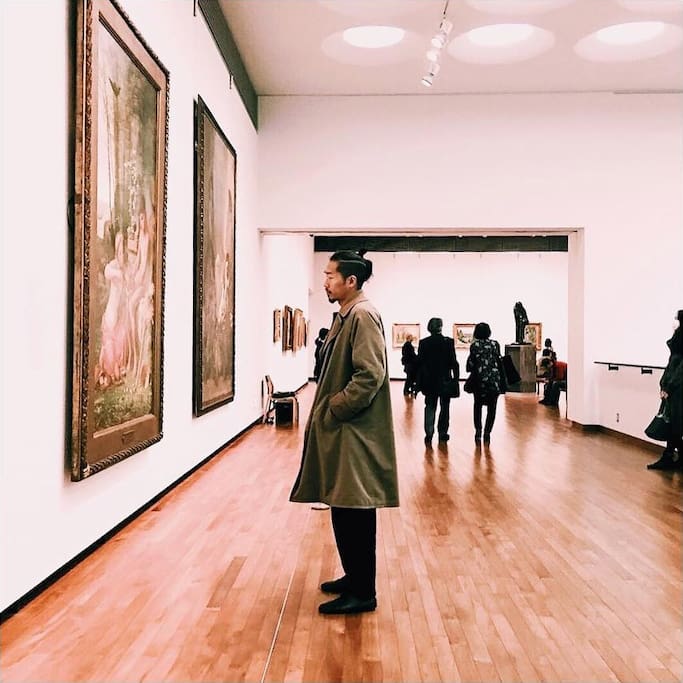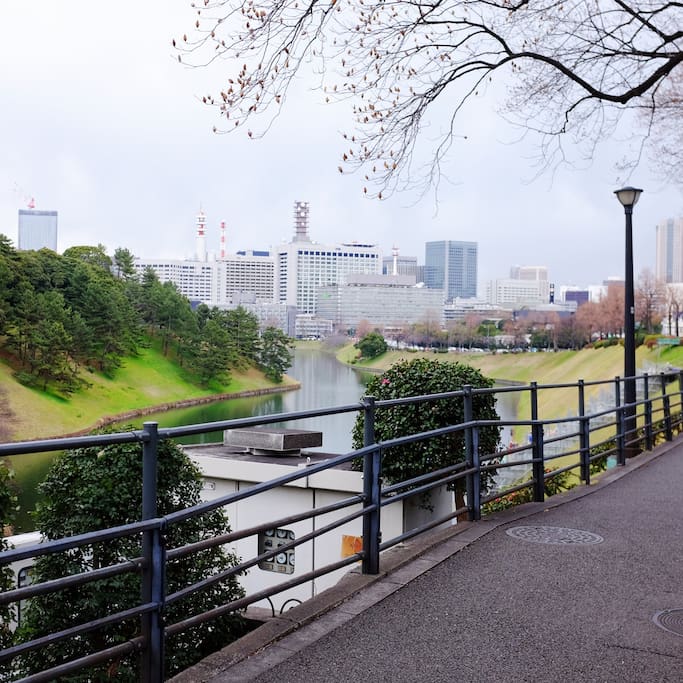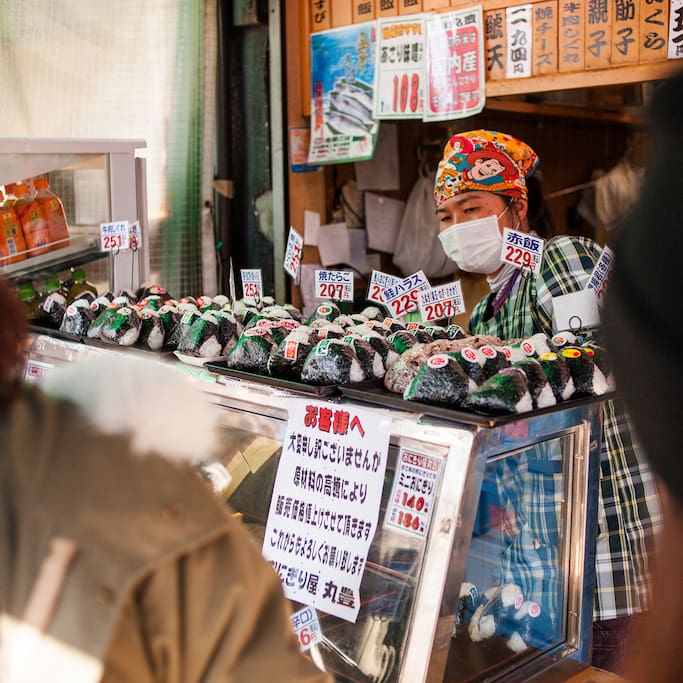Getting Around
Flughafen Narita International
1-1 FurugomeNarita International Airport
Flughafen Haneda
Haneda International Airport
Shin Yokohama Eki station
2937 ShinoharachōShin-Yokohama station
Yurakucho Station
2-chōme-9 YūrakuchōYurakucho station
Shinjuku Station
3-chōme-38-1 ShinjukuShinjuku station
Shibuya Sky Souvenir Shop
2-chōme-24 ShibuyaShibuya station
Shinagawa Station
3-chōme-26-27 TakanawaShinagawa station
Tokyo Station Galerie
1-chōme-9-1 MarunouchiTokyo station
Ikebukuro Station
1-chōme-28 MinamiikebukuroIkebukuro station.
Monzennakacho
Monzennaka-cho station
Entertainment & Activities
"Ooedo Onsen" You can enjoy many various onsen(hot spring).
183 Einheimische empfehlen
Oedo Onsen Monogatari Hot Springs
2-chōme-6-3 Aomi"Ooedo Onsen" You can enjoy many various onsen(hot spring).
Tokyo Disney Resort
MaihamaTokyo Disney Resort
Ueno-Zoo
9-83 UenokōenUeno Zoo
Arts & Culture
Kabuki-za (歌舞伎座) in Ginza is the principal theater in Tokyo for the traditional kabuki drama form. The Kabuki-za was originally opened by a Meiji era journalist, Fukuchi Gen'ichirō.
404 Einheimische empfehlen
Kabukiza-Turm
4-chōme-12-15 GinzaKabuki-za (歌舞伎座) in Ginza is the principal theater in Tokyo for the traditional kabuki drama form. The Kabuki-za was originally opened by a Meiji era journalist, Fukuchi Gen'ichirō.
The Ghibli Museum (三鷹の森ジブリ美術館 Mitaka no Mori Jiburi Bijutsukan, Mitaka Forest Ghibli Museum) is a museum showcasing the work of the Japanese animation studio Studio Ghibli.
749 Einheimische empfehlen
三鷹の森ジブリ美術館
1-chōme-1-83 ShimorenjakuThe Ghibli Museum (三鷹の森ジブリ美術館 Mitaka no Mori Jiburi Bijutsukan, Mitaka Forest Ghibli Museum) is a museum showcasing the work of the Japanese animation studio Studio Ghibli.
The Tokyo National Museum (東京国立博物館 Tōkyō Kokuritsu Hakubutsukan), or TNM, established in 1872, is the oldest Japanese national museum, the largest art museum in Japan and one of the largest art museums in the world.
206 Einheimische empfehlen
Nationalmuseum Tokio
13-9 UenokōenThe Tokyo National Museum (東京国立博物館 Tōkyō Kokuritsu Hakubutsukan), or TNM, established in 1872, is the oldest Japanese national museum, the largest art museum in Japan and one of the largest art museums in the world.
The National Museum of Western Art (国立西洋美術館 Kokuritsu Seiyō Bijutsukan) is the premier public art gallery in Japan specializing in art from the Western tradition.
246 Einheimische empfehlen
Nationalmuseum für westliche Kunst
7-7 UenokōenThe National Museum of Western Art (国立西洋美術館 Kokuritsu Seiyō Bijutsukan) is the premier public art gallery in Japan specializing in art from the Western tradition.
Parks & Nature
Shinjuku Gyoen National Garden (新宿御苑 Shinjuku Gyoen) is a large park and garden in Shinjuku and Shibuya. It was originally a residence of the Naitō family in the Edo period. Afterwards, it became a garden under the management of the Imperial Household Agency of Japan. It is now a national park under the jurisdiction of the Ministry of the Environment.
2181 Einheimische empfehlen
Shinjuku Gyoen
11 NaitōmachiShinjuku Gyoen National Garden (新宿御苑 Shinjuku Gyoen) is a large park and garden in Shinjuku and Shibuya. It was originally a residence of the Naitō family in the Edo period. Afterwards, it became a garden under the management of the Imperial Household Agency of Japan. It is now a national park under the jurisdiction of the Ministry of the Environment.
Yoyogi Park (代々木公園 Yoyogi kōen) is a park in Shibuya, Tokyo, Japan, located adjacent to Harajuku Station and Meiji Shrine.
1380 Einheimische empfehlen
Yoyogi-Park
2-1 YoyogikamizonochōYoyogi Park (代々木公園 Yoyogi kōen) is a park in Shibuya, Tokyo, Japan, located adjacent to Harajuku Station and Meiji Shrine.
Ueno Park (上野公園 Ueno Kōen) is a spacious public park in the Ueno district of Taitō, Tokyo, Japan. The park was established in 1873 on lands formerly belonging to the temple of Kan'ei-ji. Amongst the country's first public parks, it was founded following the western example as part of the borrowing and assimilation of international practices that characterizes the early Meiji period. The home of a number of major museums, Ueno Park is also celebrated in spring for its cherry blossoms and hanami.
314 Einheimische empfehlen
Uenokoen
Ueno Park (上野公園 Ueno Kōen) is a spacious public park in the Ueno district of Taitō, Tokyo, Japan. The park was established in 1873 on lands formerly belonging to the temple of Kan'ei-ji. Amongst the country's first public parks, it was founded following the western example as part of the borrowing and assimilation of international practices that characterizes the early Meiji period. The home of a number of major museums, Ueno Park is also celebrated in spring for its cherry blossoms and hanami.
Sightseeing
Akasaka Palace (赤坂離宮 Akasaka rikyu), or the State Guest House (迎賓館 Geihinkan), is one of the two State Guesthouses of the Government of Japan. The palace was originally built as the Imperial Palace for the Crown Prince (東宮御所 Togu gosho) in 1909.
51 Einheimische empfehlen
Palast Akasaka (Regierungsgebäude)
2-chōme-1-1 MotoakasakaAkasaka Palace (赤坂離宮 Akasaka rikyu), or the State Guest House (迎賓館 Geihinkan), is one of the two State Guesthouses of the Government of Japan. The palace was originally built as the Imperial Palace for the Crown Prince (東宮御所 Togu gosho) in 1909.
Asakusa Shrine (浅草神社 Asakusa-jinja), also known as Sanja-sama ("Shrine of the Three gods"), is one of the most famous Shinto shrines in Tokyo. Located in Asakusa, the shrine honors the three men who founded the Sensō-ji.
41 Einheimische empfehlen
Asakusa-Schrein
2-chōme-3-1 AsakusaAsakusa Shrine (浅草神社 Asakusa-jinja), also known as Sanja-sama ("Shrine of the Three gods"), is one of the most famous Shinto shrines in Tokyo. Located in Asakusa, the shrine honors the three men who founded the Sensō-ji.
Tokyo Skytree (東京スカイツリー Tōkyō Sukaitsurī) is a broadcasting, restaurant, and observation tower. It became the tallest structure in Japan in 2010 and reached its full height of 634.0 metres (2,080 ft) in March 2011, making it the tallest tower in the world, displacing the Canton Tower, and the second tallest structure in the world after the Burj Khalifa (829.8 m/2,722 ft).
1847 Einheimische empfehlen
Tokyo Skytree
1-chōme-1-2 OshiageTokyo Skytree (東京スカイツリー Tōkyō Sukaitsurī) is a broadcasting, restaurant, and observation tower. It became the tallest structure in Japan in 2010 and reached its full height of 634.0 metres (2,080 ft) in March 2011, making it the tallest tower in the world, displacing the Canton Tower, and the second tallest structure in the world after the Burj Khalifa (829.8 m/2,722 ft).
Tokyo Tower (東京タワー Tōkyō tawā) is a communications and observation tower in the Shiba-koen. At 332.9 metres (1,092 ft), it is the second-tallest structure in Japan.
1436 Einheimische empfehlen
Tokyo Tower
4-chōme-2-8 ShibakōenTokyo Tower (東京タワー Tōkyō tawā) is a communications and observation tower in the Shiba-koen. At 332.9 metres (1,092 ft), it is the second-tallest structure in Japan.
The Tokyo Imperial Palace (皇居 Kōkyo, literally "Imperial Residence") is the primary residence of the Emperor of Japan. It is a large park-like area located in the Chiyoda ward of Tokyo and contains buildings including the main palace (宮殿 Kyūden), the private residences of the Imperial Family, an archive, museums and administrative offices.
377 Einheimische empfehlen
Kaiserpalast
1-1 ChiyodaThe Tokyo Imperial Palace (皇居 Kōkyo, literally "Imperial Residence") is the primary residence of the Emperor of Japan. It is a large park-like area located in the Chiyoda ward of Tokyo and contains buildings including the main palace (宮殿 Kyūden), the private residences of the Imperial Family, an archive, museums and administrative offices.
The Tsukiji Market (築地市場 Tsukiji shijō), supervised by the Tokyo Metropolitan Central Wholesale Market (東京都中央卸売市場 Tōkyō-to Chūō Oroshiuri Shijō) of the Tokyo Metropolitan Bureau of Industrial and Labor Affairs, is the biggest wholesale fish and seafood market in the world and also one of the largest wholesale food markets of any kind.
1032 Einheimische empfehlen
Tsukiji-Fischmarkt
4 Chome-13 TsukijiThe Tsukiji Market (築地市場 Tsukiji shijō), supervised by the Tokyo Metropolitan Central Wholesale Market (東京都中央卸売市場 Tōkyō-to Chūō Oroshiuri Shijō) of the Tokyo Metropolitan Bureau of Industrial and Labor Affairs, is the biggest wholesale fish and seafood market in the world and also one of the largest wholesale food markets of any kind.
Ameya-Yokochō (アメヤ横丁 Ameya alley) is an open-air market in the Taito Ward, located next to Ueno Station. The market is approximately 164,227 square feet in area, starting just behind the Yodobashi Camera building and following the Yamanote Line south until the Komuro building.
549 Einheimische empfehlen
Ameyoko
4 Chome-7 UenoAmeya-Yokochō (アメヤ横丁 Ameya alley) is an open-air market in the Taito Ward, located next to Ueno Station. The market is approximately 164,227 square feet in area, starting just behind the Yodobashi Camera building and following the Yamanote Line south until the Komuro building.
Meiji Shrine (明治神宮 Meiji Jingū), located in Shibuya, is the Shinto shrine that is dedicated to the deified spirits of Emperor Meiji and his wife, Empress Shōken. The shrine does not contain the emperor's grave, which is located at Fushimi-momoyama, south of Kyoto.
1219 Einheimische empfehlen
Meiji-Schrein Schatzhaus
1-1 YoyogikamizonochōMeiji Shrine (明治神宮 Meiji Jingū), located in Shibuya, is the Shinto shrine that is dedicated to the deified spirits of Emperor Meiji and his wife, Empress Shōken. The shrine does not contain the emperor's grave, which is located at Fushimi-momoyama, south of Kyoto.
Essentials
Daily Yamazaki
3-chōme-16-1 AsakusaDaily Yamazaki : OPEN 24hours
FamilyMart
3-chōme-3-7 RoppongiFamily Mart : OPEN 24hours
Food Scene
Bisutora / You can enjoy Italian food with relaxing atmosphere. OPEN : 18:00-26:00(Mon-Thu), 18:00-28:00(Fri-Sat), 19:00-28:00(Sun)
びす寅
1-chōme-3-2 TomiokaBisutora / You can enjoy Italian food with relaxing atmosphere. OPEN : 18:00-26:00(Mon-Thu), 18:00-28:00(Fri-Sat), 19:00-28:00(Sun)
Ootoya
6-chōme-27-30 ShinjukuOtoya / Japanese food chain restaurant. OPEN : 11:00-23:00
Uosa Sakaba / It very famous shop. You can enjoy to eat Sashimi(low fish). OPEN : 16:00-22:00
7 Einheimische empfehlen
魚三酒場
1-chōme-5-4 TomiokaUosa Sakaba / It very famous shop. You can enjoy to eat Sashimi(low fish). OPEN : 16:00-22:00
PUERTA
1-chōme-3-6 TomiokaPuerta / Portugal and Spanish restaurant. OPEN : 11:30-14:00, 17:00-29:00
Nikusushi / You can enjoy to eat Niku-sushi. Sushi is usually use low fish, but Niku-sushi mainly use beef. OPEN : 17:00-25:00(Sun-Thu), 17:00-28:00(Fri-Sat)
Monzennakacho Niku Sushi
1-chōme-4-3 TomiokaNikusushi / You can enjoy to eat Niku-sushi. Sushi is usually use low fish, but Niku-sushi mainly use beef. OPEN : 17:00-25:00(Sun-Thu), 17:00-28:00(Fri-Sat)
YAYOI KEN
5-chōme-2-3 KibaYayoi-ken / Japanese food chain restaurant. OPEN : 7:00-24:00





